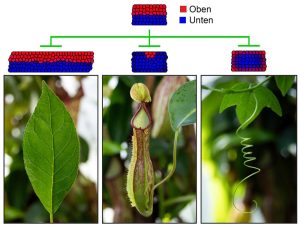Shaping: Plant leaves need as much space as possible to capture sunlight. But how do they get their flat shape? Biologists have now deciphered the genetic mechanisms that control the flat growth of leaves. Accordingly, a kind of built-in GPS informs each leaf cell about its relative position in the developing leaf. The resulting pattern of top and bottom is consistent with the biological concept of self-organization proposed by mathematician Alan Turing.
Plants produce energy through photosynthesis. To capture light, its leaves contain a special light-collecting apparatus and the green plant pigment chlorophyll. For best light output and efficient mass exchange, the leaves are as flat and thin as possible. But first they have to grow into this shape: “When cells divide and multiply, they usually form a mass of cells,” explains Emanuel Scacchi of the University of Tübingen. “We wanted to know how, in the case of a leaf, a large space could become.”
To find out, Scacchi's team examined the development of the model plant Arabidopsis thaliana. The researchers analyzed the genetic processes during plant growth and their visible development under high-resolution microscopes. Biologists also collaborated with mathematicians who reproduced experimental observations in computer models.
RNAs as molecular positioning systems and gene switches
The analyzes revealed that small RNA molecules control leaf growth. With their help, individual leaf cells communicate with each other and thus find out their relative position to each other in the structure. RNAs act as a kind of molecular GPS signals in leaves, biologists report. “Small RNA molecules found in the cells of a developing leaf initiate a genetic process that allows cells to sense and interpret their environment,” Scacchi says.
These RNAs also coordinate which genes need to be activated or inhibited in the cells at the top and bottom of the leaf to give it the correct form and function. Genetic activities are coordinated such that the upper and lower parts are sharply separated from each other and the leaf surfaces form a flat plate ideal for photosynthesis, the researchers report.

Leaf cells organize themselves
What was also surprising was that “this control mechanism operates independently in the developing leaf, and there is no central control in the plant,” says lead researcher Marja Timmermans from the University of Tübingen. This means that gene activity can quickly adapt to internal and external disturbances in leaf development. Even if growing conditions change radically, the leaves can still maintain the correct shape.
“This genetic system also offers many possibilities for fine-tuning,” says Timmermans. Depending on how strongly the RNA interferes, the shape of the leaf changes. “This explains the diversity of leaf shapes observed in nature – from the simple tendril of climbing plants to the complex pitcher trap of carnivorous plants.” Thus, the RNAi machinery can be used to generate different leaf shapes among different species, but also different shapes between species. Several types of specimens of the same species.
Plants develop according to Turing's model
When these observations were transferred into computer models, mathematicians discovered that the biological pattern in plant leaves was not new. “We noticed that our results are consistent with a theory put forward by Alan Turing more than seven decades ago,” says Timmermans. Although the British mathematician is now known as a computer pioneer, he also studied the mysteries of nature.
Turing proposed that simple interactions of certain molecules in the cells of living organisms could lead to the formation of complex patterns, such as the spots on a tiger's skin or the stripes of a zebra. He described this in his theory of gestalt formation. “We have discovered a mechanism controlled by small RNA molecules, which is consistent with Turing's concept of pattern formation through self-organization,” says Timmermans.
In the case of leaves, self-organization refers to the genetically controlled behavior of cells that form an array to produce a coherent organized pattern and the flat structure of the leaf. “The basis for the formation of this pattern is polarity, in this case the ability to distinguish between up and down. This is usually caused by a concentration gradient of a substance that is lower on one side and higher on the other,” Scacchi explains.
Application in plant breeding is possible
“Our discovery is not only important for adding a new chapter to Turing's legacy,” says Timmermans. By knowing the basic mechanisms by which small RNAs enable self-regulatory genetic processes, we can now explore how we can benefit from them. The results could, for example, be used to develop more resistant plant varieties. “With food demand increasing around the world, we need improved crops with high yields that are resistant to stressors such as global warming,” explains Timmermans. (Nature Plants, 2024, doi: 10.1038/s41477-024-01634-
Source: Eberhard Karls University Tübingen
March 27, 2024 – Claudia Crabb






More Stories
Ubisoft wants to release a new Assassin's Creed game every 6 months!
A horror game from former developers at Rockstar
Turtle Beach offers the Stealth Pivot Controller for PC and Xbox